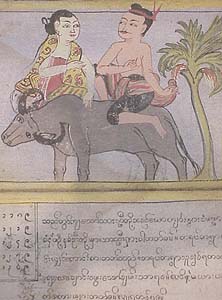Myanmar’s neighbors
had quite a lot to do with Myanmar’s arts with China, India, and Thailand contributing
the most influence. Much of their early arts were tied to Buddhism (and some to
Hindu) with images, sculptures, and scenes of Buddha and other key figures.
However, the people here developed their own stylistic variations from that of
China and Thailand, for example.
There are ten key
traditional arts in Burmese art. These ten arts were mainly handicrafts and
sculpting: stone carving, masonry, turnery (a type of wood carving where the
wood turns on a spindle), stucco relief, painting, goldsmith, lacquerware,
woodcarving, bronze casting, and blacksmith. There are actually other arts that
were practiced in Myanmar that are not included in those ten, which include
textile arts (tapestry making and silk weaving), pottery, gold leaf making, and
engraving (especially on gems).
Today, Burmese
artists span an array of artistic styles and mediums. Even in their abstract
art, more often than not, there seems to be a tie back to their own culture in
some way. Many art students study in art schools and art departments throughout
Myanmar, while others may choose to travel abroad. Some artists, like Po Po are
self-taught (some people are always looking out for Po Po). Some artists like
Aung Myint and Aye Ko have had exhibitions across the world.
Literature in
Myanmar is mainly written in Burmese. Early literature was mainly centered
around Buddhism. The Jataka Tales are one of the major early works. Orthodox
Buddhism forbids fiction (this was new to me), so literature tended to be
written as non-fiction. Poetry has long been a popular literary form.
Since the British
came, novels became popular along with short stories. However, novels are
scrutinized and tend to be harder to publish due to censorship issues coupled
with the fact that many people can’t afford to buy novels. Those may be some
reasons why many writers choose to write short stories instead. Another niche
many writers have gone into is translations. Western novels are quite popular,
and thanks to the efforts of the translators, these novels are made available
in Burmese. (However, there may be some issues with Myanmar not signing the Universal
Copyright Convention Agreement, which leads them to not paying royalties to the
original authors. I tried to find this information expressly written elsewhere,
but I didn’t do an extensive search, so help me out with this part.)
There have been
several women who have risen to notoriety. Two of these writers include Kyaw Ma
Ma Lay and Khin Myo Chit. Other writers worth mentioning include Thein Pe
Myint, Mya Than Tint, Kyi Aye, San San Nweh, and Khin Hnin Yu.
Up next: music and
dance





No comments:
Post a Comment